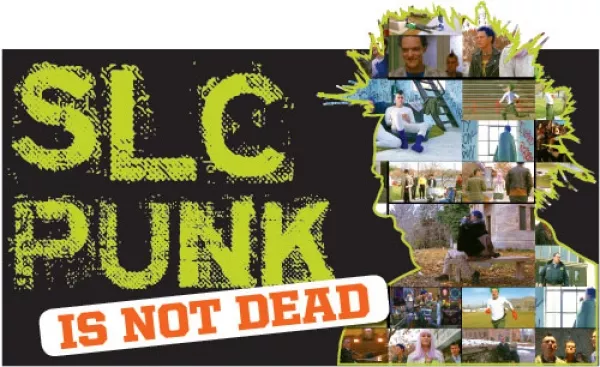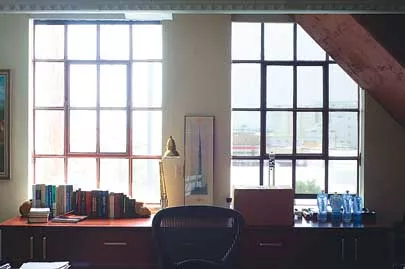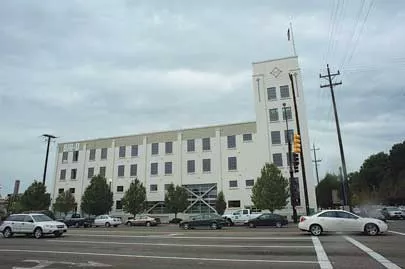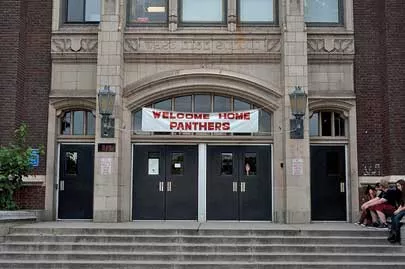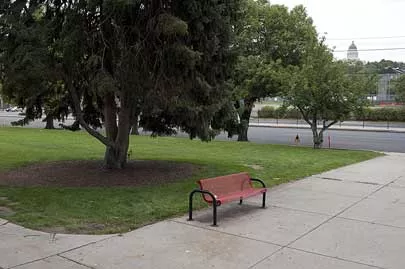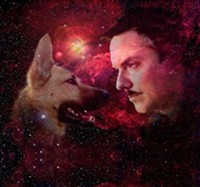SLC Punk Is Not Dead
A look back at the film that made the city an icon 15 years ago
By Colin Wolf @wolfcolin“I know I made quite a few people angry with that film, punks in general,” says director James Merendino about his low-budget indie film SLC Punk. “I was definitely entering a world of pain by making a movie about punk rock, period.” It’s been 15 years since former Salt Lake City resident James Merendino filmed his blue-haired adolescent tour through the Mormon capital.
The film—which is getting a sequel next year—initially pissed off punks (and the majority of Utahns), but now, strangely enough, haters claim to have been best friends with the inspiration for the main character, Stevo, a trust-fund dickhead who eats acid, fights rednecks and hates his parents before selling out and going to law school. Out-of-state transplants watch the film in hopes that questions about Salt Lake City will be answered in quippy monologues like “It’s like Jesus Christ took a shit and it landed right here.” And teenagers from spots like New Jersey idolize it to the point that they’ll Sharpie quotes on torn denim and sell it on Etsy (yes, this exists).
“At the time, a lot of people thought I had misrepresented the scene somehow, and I was kind of confused because, well, it’s fiction,” Merendino says. “It’s my personal observations on being an outsider. I used to drive to Evanston to get beer, and I definitely used to go to punk shows all the time at the Indian Center. I did do those things. “I got my ass kicked a lot too,” he adds.
But whether the film is punk enough or if it accurately represented Salt Lake City doesn’t seem to matter anymore. At this point, SLC Punk, whether you love it or hate it, is Utah’s most iconic and identifiable film.
Hey, it could be worse. Be thankful we’re not stuck with John Woo’s southern Utah-set action flick Broken Arrow. Or, hell, we could be aligned with Napoleon Dynamite, like our neighbors in Idaho. Unfortunately, we don’t choose the films that define our homes—we are beaten over the head with them. And despite the initial kicking and screaming, years of festering and cult-like consumption will eventually force us to pound our fists on the table and admit, “Fine. Fuck. You’re right. SLC Punk is a pretty damned good movie!”
“I do recall your paper did say, “There’s about as much SLC punk in SLC Punk as there is in Touched By an Angel or whatever show they were shooting out there back then,” Merendino jokes. What he’s referring to is City Weekly’s April 22, 1999, issue, where staff film critic Greg Beachman reviewed SLC Punk and gave it 2 1/2 stars, stating, “SLC Punk is a soap-on-a-rope wrapped in shiny paper and bright ribbon, a simple, tedious message stuffed inside elaborate packaging. … The subcultures of Utah, as those who live here know all too well, just aren’t that interesting.”
We can admit when we were wrong. We also gave EDTV three stars, but what are you going to do? Gradual sea changes in attitudes about films are the norm. In retrospect, some of Beachman’s observations are now SLC Punk’s best attributes. Smash-cut editing is now commonplace in films, and Merendino’s decision to film SLC Punk in the least punk place possible is probably the most important aspect of the film.
“I lived [in SLC], so I could talk about it,” Merendino says. “At the time, L.A. or New York punks just weren’t that interesting to me. That’s why it’s interesting to say there’s punk in SLC. It’s a forgone conclusion. Now, people say, ‘Oh, you lived in Utah, isn’t that a place where there’s punks?’ I doubt they would have said that in 1997.”
This accidental punk image wasn’t necessarily a great thing for Salt Lake City. On the 10th anniversary of the film, City Weekly writer Gavin Sheehan pointed out on his blog, Gavin’s Underground, that “SLC Punk had a lot of negative effects, especially on people who have a habit of becoming obsessed: assholes who immediately went off on quests to find the real ‘Stevo,’ questioning the three women who made up ‘Trish’ or harassing the late Sean Fightmaster. But I believe the worst of these types were the ‘Bob hunters’—groups who found each other during the Internet chat boom, planning get-togethers all centered around the sick fascination of finding the grave of the real Heroin Bob.”
The success of the film also hindered Merendino’s career, transforming the director into an unwilling representative of all things punk rock. “I was getting meetings to do big studio movies but they kept saying, ‘Well, we’re afraid of you directing the movie because you’re a punk. You’ll be all anarchy on the set,’” Merendino says. “And I’m like, ‘What are you talking about? I’m a director. I make movies.’ They made an assumption about the movie that I just threw everything in the air and somehow SLC Punk just came out of it. I missed some good opportunities because of that movie. Listen, I don’t represent any part of any punk movement, at all. There are people who do, but I’m not one of them.”
But luckily for Merendino, who spent the past 15 years writing and directing a handful of movies that saw lukewarm receptions from critics, SLC Punk was a long-term success, thanks to a strong DVD release from Sony.
After those steady sales and a good run on Netflix, it made sense for the 44-year-old director to follow his most successful film with a sequel, SLC Punk 2: Punk’s Dead. But it’s not a studio cash-grab or the standard sequel rehash of the first movie—it’s Merendino doing what he does best: spouting off about punk rock.“The studio couldn’t give a shit about this movie, this is entirely my decision. I’ve said this before, when I want to tell a story about how I see things, I like to rant, so I created this structure with SLC Punk so I could literally just rant and digress, whatever. It’s sort of my sandbox.”
And Merendino only rants about what he knows, which is why Punk’s Dead will not be about, or filmed in, Salt Lake City. “I mean, I’m not going to go back and rehash what it’s like to live in Salt Lake City, because I don’t have that experience anymore. I’m not going to bullshit anyone. The movie centers on the aftermath of Heroin Bob’s death. I can’t say much more than that, other than it’s about all the characters coming back together: Stevo, Sean, Mike, Trish, John the Mod—most of the actors are signed on.” The film is set to be released in summer 2014.
Even as work on the sequel moves forward, Merendino says he’s still shocked that film people still care about a film he shot 15 years ago.
“Things grow on people, I guess, and that’s OK. I didn’t realize the film had an impact at all, mostly because people in Salt Lake City disliked the movie ... a lot. That is, until I announced I was going to make a sequel. Then they all said, ‘How dare you make a sequel to that amazing movie!’”
SLC Punk was filmed in the pre-digital year of 1998, meaning, unfortunately, that most of the film's productions notes are either lost or gone for good. But with a little help from writer and director James Merendino, assistant director Matias Alverez and prop master Scott Arnemen, we were able to track down most of the film's more iconic film locations.
Stevo and Heroin Bob’s Apartment
Stevo and Heroin Bob lived in the most punk-rock place possible: a graffiti-filled loft in a condemned building adjacent to a freeway offramp on the corner of 400 West and 400 South. The offramp is gone, and the building is now owned by Big-D construction. The loft apartment is now the well-furnished office of Big-D’s chairman—his desk is pretty much in the same spot as that disgusting floor mattress—but photos of how the building looked pre-renovation are on display in the basement.
More by Colin Wolf
-
Catching Up With DJ Matty Mo
2014's DJ of the Year is keeping the good kind of busy
- Jan 7, 2015
-
Best Local Rap of 2014
Utah-released hip-hop you shouldn't sleep on
- Dec 31, 2014
-
There's a Michael Jackson tribute band in Park City tonight
- Dec 29, 2014
- More »
Latest in Cover Story
Readers also liked…
-
Forget the family pedigree—Robert F. Kennedy Jr should not be the next president of the United States
Trojan Horse
- Jun 21, 2023
-
Women decry harassment and toxic culture at St. George auto dealership
Men at Work
- Oct 11, 2023


